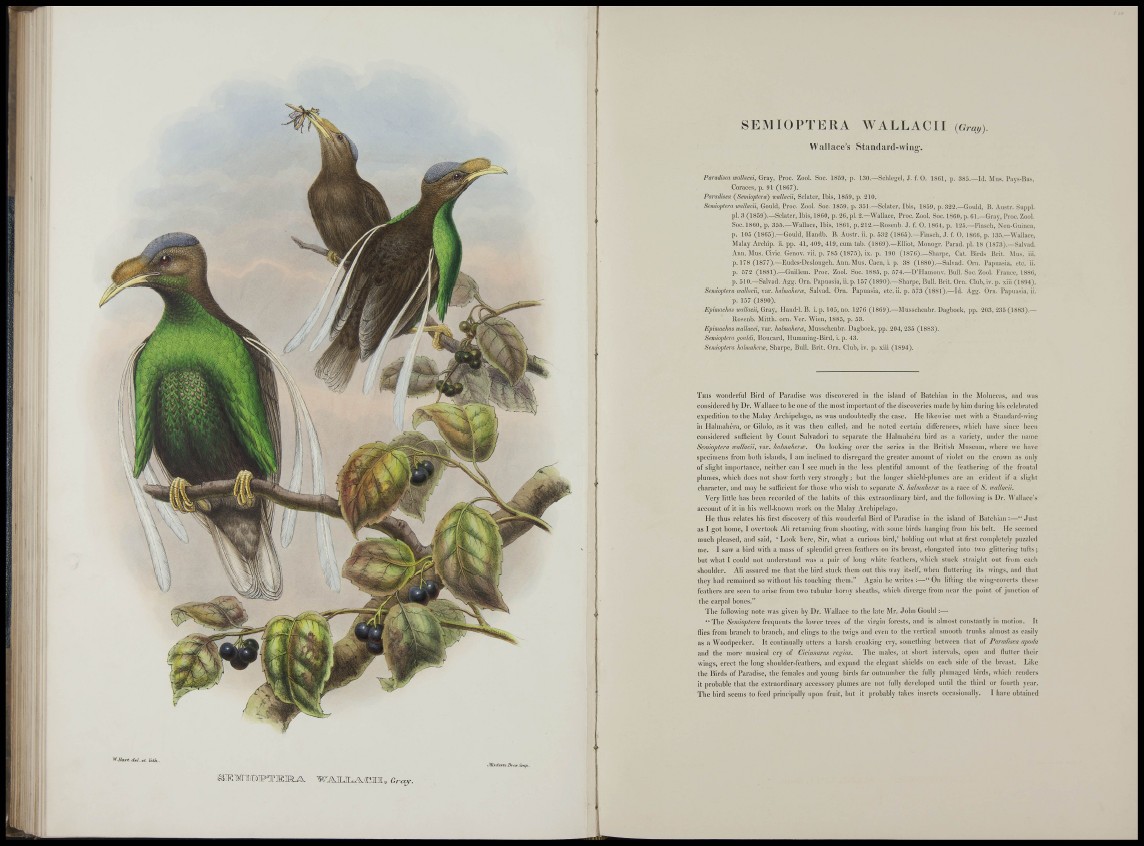
V.lUi-r rf,/.,t litK.
• Vúitei^i Br-fe rrrifi.
áJnSlICKDF'TIEIR^ Grav.
--.LI,-,...- , - . ^ r - • ..- i-- > •-..-
SEiAJIOPTERA WALLACH {(h-ajj).
WalIcace's Standard-wiii"-.
Paradisea wttllacei, Gray, Prue. Zool. Soc. 1859, p. I.'ÌO.—Sclilegel, J. f. O. 18(il, p. ;¡8j.—Id. Mus. l'ays-liaf.,
Coraces, p. 91 (1867).
Paradisea QSemioptera) wallacii, Sclater, Ibis, 1859, p. 210.
Semioptem walkcii, Gould, Proc. Zool, Soc. 1859, p. 351.—Sclater, Ibis, 1859, p. 322.—Gould, li. Austr. Sappi.
pi. 3 (1859).—Sclater, Ibis, 18(i0, p. 2ü,pl. 2.—Wallace, Proc. Zool. Soc. 18(i0,p. (il.—Gray, Proc. Zool.
Soc. 18C0, p. 355.—Wallace, Ibis, 1801, p. 212.—Rosenb, J. f. O. 1804, p. 125.—Finscb, Ncu-Guinea,
p. 105 (1805).—Gould, Handb. B. Austr. ii. p. 532 (1805).-Fi i isch, .1. f. (). 1800, p. 135.-Wallace,
Malay Archip. ii. pp. 41, 409, 419, cum tab. (18()9).—Elliot, Moiiogr. Parad, pi. 18 (1873).—Salvad.
Ann. Mus. Civic. Geuov.-vii. p. 785 (1876), ix. p. 190 (1870).—Sharpe, Cat. Birds Brit. .\lus. iii.
p. 178 (1877).—Eudes-Deslongch. Ann. Mus. Caen, i. p. 38 (1880).—Salvad. Orn. Papuasia, etc. ii.
p. 572 (1881).—Guillem. Proc. Zool. Soc. 1885, p. 574.—D'Hamouv. Bull. Soc. Zool. Fraucc, 1880,
p. 510.—Salvad. Agg. Orn. Papuasia, ii.p. 157 (1890) .—Sharpe, Bull. Brit. Orn. Club, iv. p. xiii (1894).
Seiniopiera wallacii^ Yav. halmaherie, Salvad. Orn. Papuasia, etc. ii. p. 573 (1881).—Id. Agg. Oni. Papuasia, ii.
p. 157 (1890).
Epimachus wallacii, Gvay, Hand-1. B. i. p. 105, no. 1270 (I8C9).—Musschcnbr. Uagboek, ])p. 203,235(1883).—
Rosenb. Mitth. orn. Ver. Wien, 1885, p. 53.
Epimachus wallacei, var. halmaheì'iE, Musschenbr. Dagboek, pp. 204, 235 (1883).
Semioptera gonidi, Boucard, Ilummiug-Bird, i. p. 43.
Semiopiera halmalierce, Sharpe, Bull. Brit. Oru. Club, iv. p. xiii (1894).
THIS wonderful Bird of Paradise was discovered in the island of liatcliian in the Moluccas, and was
considered by Dr. Wallace to be one of the most important of the discoveries made by bini during his celebrated
ex[)edition to the Malay Arciii[)elago, as was imdoiibtcdly the case. He likewise met with a Standard-wing
in Hahnahera, or Gilolo, as it was tlieii called, aiid he tioted certain diUcrences, which have since been
considered sufficient by Count Salvador! to se[)arate the Malinahe'ra bird as a variety, under the name
Semioptera wallacH, var. hulmaherte. On looking over the series in the liritish iMiiseiim, where we have
specimens from both islands, I am inclined to disregard the greater amount of violet on the crown as otily
of slight importance, neither can I see nuich in the less j)lentiful aniounl of the feathering of the frontal
plumes, which does not show forth very strongly ; but the longer shielii-j)lurnes are an evident if a slight
character, and may be sufficient for those who wish to separate S. Italmuhcrw as a race of S. Kulladi.
Very little has been recorded of the habits of this extraordinary bird, and the follouing is Dr. Wallace's
account of it in his well-known work on the Malay Archipehigo.
He thus relates his fir.st iliscovery of this wonderful ]5ird of Paratlise in the island of Batcliian :—"Just
as I got home, I overtook Ali returning from shooting, with some birds hanging from his belt. He seemed
much pleased, and said, ' Look here. Sir, what a curious biril,' holding out what at first completely j)U7.7,led
me. I saw a bird with a mass of s])lendid green feathers on its breast, elongated into two glittering tufts;
bat what I could not understand was a pair of long white feathers, which stuck straight out from each
shoulder. Ali assured me that the bird stuck them out this way itself, when fluttering its wings, and that
they had remained so without his touching them." Again he writes :—" On lifting the wing-coverts these
feathers are seen to arise from two tubular horny sheaths, which diverge from near the point of jimction of
the carpal hones."
'J'he following note was given by Dr. Wallace to the late Mr. John Gould :—
" T h e Semioptera frequents the lower trees of the virgin forests, and is almost constantly in motion. It
Hies from branch to branch, and clings to the twigs and even to the vertical smooth trunks almost as easily
as a Woodjieeker. It contimndly utters a harsh croaking cry, something between that of Puraitisea upodu
and the more musical cry of Cicimmrus regius. The males, at short intervals, open and (hitter their
wings, erect the long shoulder-feathers, and expand the elegajit shields on each side of the breast. Like
tlie Birds of Paradise, the females and young birds far outnumber the fully plumaged birds, which renders
it probable that the extraordinary accessory plumes are not fully developed until the third or fourth year.
The bird seems to feed principally upon fruit, but it probably takes insects occasionally. I have obtained
rT-'v.